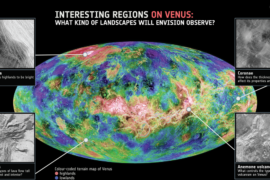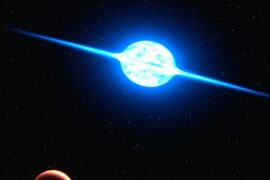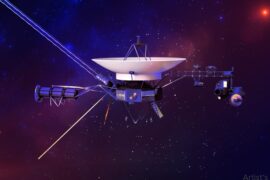What is a meteor?
A meteor is a piece of rock, dust and/or metal that has entered Earth’s atmosphere after orbiting the Sun. Most of them burn up and evaporate due to the heat, but every once in a while one survives the trip and lands. When that happens, its classification changes from a meteor to a meteorite.
Prior to crossing paths with a planet, meteors are known as meteoroids and they have many different origins. For example, they can be the result of a piece of debris that resulted from the collision of two asteroids in the asteroid belt, they can be pieces of planets or moons that detached after a collision with a big object, or they can simply be leftover material left from the beginnings of the Solar system.
While most meteors are harmless, the large ones pose a threat to life on any planet because they are more likely to collide with the surface, potentially causing an extinction-level event. This is why it is important for space agencies to keep track of the big meteoroids that could have an orbit that coincides with ours.
How big are meteors?

Meteors come in all kinds of shapes and sizes. As a general rule, meteors are much smaller than asteroids and much much smaller than moons, dwarf planets, or planets.
Most meteors are the size of a pebble or even a speck of dust. The large majority weigh only between 16 grams and 1 kilogram (0.03 pounds to 2.2 pounds). They measure between 3 centimeters and 1 meter (1.1 inches to 3.25 ft).
There are a few outliers that have a diameter larger than 1 kilometer and weigh hundreds of thousands of tons.
Depending on their size, meteors are classified into 9 categories. Meteors from class 4 and above are the ones with probabilities of surviving Earth’s mesosphere (the third layer of the atmosphere) and causing an impact. Class 7 and above are considered dangerous as they are big enough to leave a crater, cause earthquakes, tidal waves, or worse.
| Meteor Class | Size | Mass | Probable Origin | Designation |
|---|---|---|---|---|
| 1 | < 100μ | Comets | Micrometeorites | |
| 2 | 100μ – 1mm | Comets | Submeteors | |
| 3 | 1mm – 3cm | Comets | Meteors | |
| 4 | 3cm – 30cm | Comets/Asteroids | Fireballs | |
| 5 | 10cm – 1m | < 100kg | Asteroids | Bolides |
| 6 | 0.4m – 4m | 100kg-100t | Asteroids | Meteorites |
| 7 | 4m – 20m | 100-10000t | Asteroids | Impactors |
| 8 | 20m – 1km | 104-1010t | Asteroids | Disasters |
| 9 | > 1km | > 1010ton | Asteroid | Catastrophe |
μ – micrometer
Meteors class 3 and above are sometimes visible in the sky as they burn up in the atmosphere. They are also known as shooting stars and when a lot of them happen at the same time, they cause a meteor shower.
Average meteor size
The average size of a meteor is less than one millimeter with a weight of a small fraction of a gram. The exact number is hard to calculate as we don’t have enough data as tracking objects that small is near impossible.
Scientists estimate the number of meteors that enter Earth’s atmosphere every single day is over 25 million. Out of those, only 17 on average are big enough to survive the trip and land on Earth, turning into meteorites. This means that even though large meteors exist, the average is largely skewed by all the tiny speck-sized particles.
As for the meteorites that manage to survive, those have an average mass between 128 and 256 grams (0.25 to 0.5 pounds) and less than 10 centimeters in diameter.
The largest meteor ever (that we know of)

The largest known meteor (or better said, meteorite) that has been found on Earth is the Hoba meteorite, in Namibia. It is over 6.5 meters (21 ft) wide and weighs more than 60 tonnes.
Hoba was discovered in 1920 and hasn’t been moved since its discovery. It is the largest piece of iron on Earth and is believed to have landed 80,000 years ago.
The larger objects that have crashed on Earth a few times in the past causing major environmental catastrophes like the one that resulted in the extinction of the dinosaurs, were not necessarily meteorites, but asteroids. The difference between them is basically the size. Asteroids are much larger than meteoroids/meteors.
The following table lists the largest meteorites that have been discovered on the planet.
| Name | Year of discovery | Location | Mass |
|---|---|---|---|
| Hoba | 1920 | Grootfontein, Namibia | 60,000 kg (130,000 lb) |
| Cape York (Ahnighito) | 1894 | Meteorite Island, Greenland | 30,875 kg (68,068 lb) |
| Campo del Cielo (Gancedo) | 2016 | Chaco, Argentina | 30,800 kg (67,900 lb) |
| Campo del Cielo (El Chaco) | 1969 | Chaco, Argentina | 28,840 kg (63,580 lb) |
| Armanty | 1898 | Xinjiang, China | 28,000 kg (62,000 lb) |
| Bacubirito | 1863 | Sinaloa, Mexico | 22,000 kg (49,000 lb) |
| Cape York (Agpalilik) | 1963 | Nordgronland, Greenland | 20,100 kg (44,300 lb) |
| Mbozi | 1930 | Mbeya, Tanzania | 16,000 kg (35,000 lb) |
| Willamette | 1902 | Oregon, United States | 14,150 kg (31,200 lb) |
| Chupaderos I | 1852 | Chihuahua, Mexico | 14,114 kg (31,116 lb) |
The sizes on this table only account for the largest single pieces of the meteorite. It does not take into account the thousands of small pieces that are scattered when the object crashes. For example, the Campo del Cielo meteorite split into thousands of pieces that are still being found hundreds of miles away from the main object. Pieces of this meteorite have been found hundreds of miles away in a different country (Chile).
Summary
- Meteors are pieces of rock (meteoroids) that enter Earth’s atmosphere
- Most meteors are very small. As small as grains of sand. Most of them evaporate in the mesosphere.
- When a meteor survives and lands, it is called a meteorite.
- The largest meteorite discovered is over 6 meters wide and weighs more than 60 tonnes.
Enjoyed this article?
Get daily 10-minute PDFs about astronomy to read before bed!
Sign up for our upcoming micro-learning service where you will learn something new about space and beyond every day while winding down.







